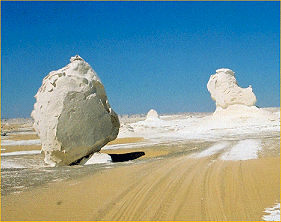I stumbled onto a thread on the Sahara Safaris discussion forum this morning which makes for interesting reading. My Google Alerts picked it up under “Gilf Kebir” but it is more concerned with the desert areas around Bahariya and Farafra, most importantly the White Desert.
I have posted both in the past and more recently about the state of tourism in the Bahariya area, and its impacts on both the desert itself and on the local community. This thread is written by those who are making a living out of running desert safaris from Bahariya and Farafra. Here’s a summary of what they have been saying.
Apparently next season new rules are to be introduced that will confine foreign tourists to traveling through the desert with licensed tour companies. The license to operate in the desert will be expensive and must be signed off by the Minister for Tourism. The thread says that a fine of LE400 will be imposed on any drivers carrying foreign travelers into the deserts. That’s a hefty 72 US dollars or 48 UKP. That would be a massive fine for a local driver.
The guys at Sahara Safaris are worried that, if implemented, this will put independent tour operators out of business, killing local enterprise and competition and giving all revenue to the already cash-rich national scale tour operator. This would leave many oasis dwellers who have invested heavily in four-wheel drive vehicles without income and without any obvious way of paying off their loans.
If this is actually the case, and it remains to be confirmed, this seems to me to be a really dreadful shame. Egypt has for a long time been encouraging people to seek work outside Cairo. The development of the New Valley (the crescent of oases from Cairo down to Luxor) was to be the foundation of a new semi rural economic model. And now that the oasis inhabitants have found a way to make tourism work for them and have used their creativity and enterprise to pull it off, they are having the rug pulled from under them. And it’s crazy. The people who live in the oases and invest in the local economy will put their wealth back into the local economy by spending and developing their businesses and employing local people.
Obviously nothing is clear cut or straight forward. Some of the inhabitants of Bahariya miss the peaceful pre-tourism rural days when the streets weren’t buzzing with four-by-fours. But it’s one thing to fear change and quite another to cut it off with an axe.
The conversation on Sahara Safaris asks the obvious question – why? Why are these licenses being imposed? Is it for “security” reasons. I don’t know the answer but I suspect that it has much to do with criticism about how the White Desert is being managed, the amount of litter that is being left there by tourists and the amount of damage that is being done. I have often thought that the way to manage tourists in these out of the way places is to impose responsibility on the tour companies. But I never had a vision of the little guys being put out of business. I never imagined excluding local people from their own landscape or indeed, their own economy.
And it I’m right about the reasons for imposing the new licenses and excluding local people from taking tours, its both an irony and unfair. Many of the single-person or family run enterprises are the ones who care for the desert and by running very small tours keep the scale of the tourist problem to a level of managing bites of the elephant. Bigger tours from Cairo are much less easy to control.
Managing the vandalism, theft, careless damage and littering in the Western Desert is a serious problem and so far no-one has come up with a viable solution. Or if they have, nothing has been implemented. If this is the implementation of a solution to protect the desert by limiting access only to licensed operators who can offer certain guarantees about managing their tour members then I can see the benefits. And if the cost of the licenses are there to fund desert clean-ups that too I understand (but doubt). But there is no reason why private oases tour organizers should not be able to offer the same guarantees and be offered a more reasonable fee for the licenses as some recompense for the invasion of their villages and recognition of their local expertise, creativity and the investment they have already made.
I think that if I was a small tour business working in the oases I would look to my fellow operators and form something of a collective – a trade association of sorts – with a charter of responsible behaviour and a set of agreements for managing both tourists and the use of the desert. That might be something with which to negotiate. There is no reason why training on heritage and environmental management and care shouldn’t be arranged by the SCA or the Ministry of Tourism for such a group.
There needs to be a more subtle solution that the one being debated, and it needs to include those who live and work in the oases, not exclude them. I sincerely hope that matters are not really unfolding as they have been described.
